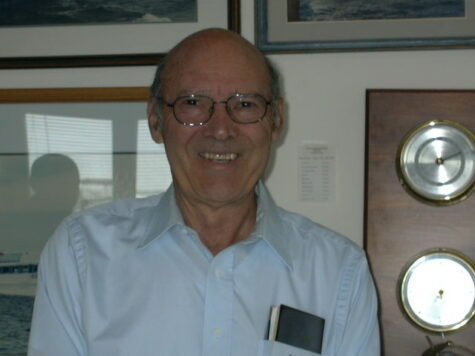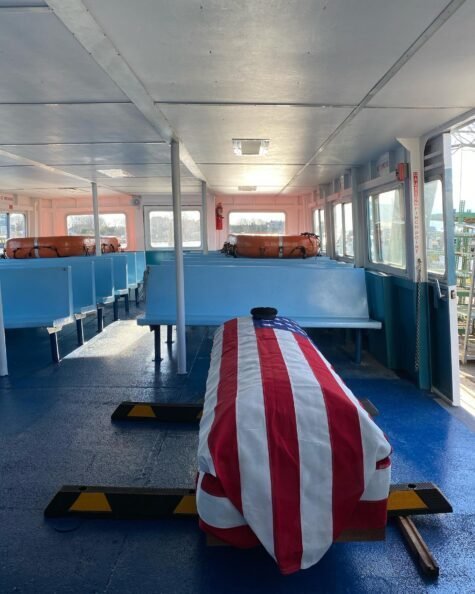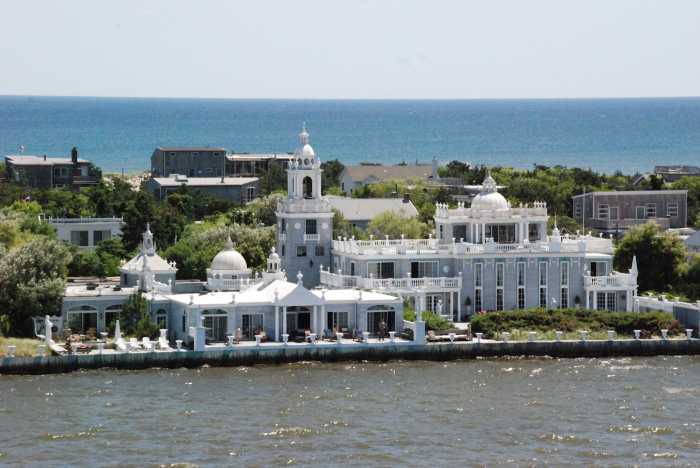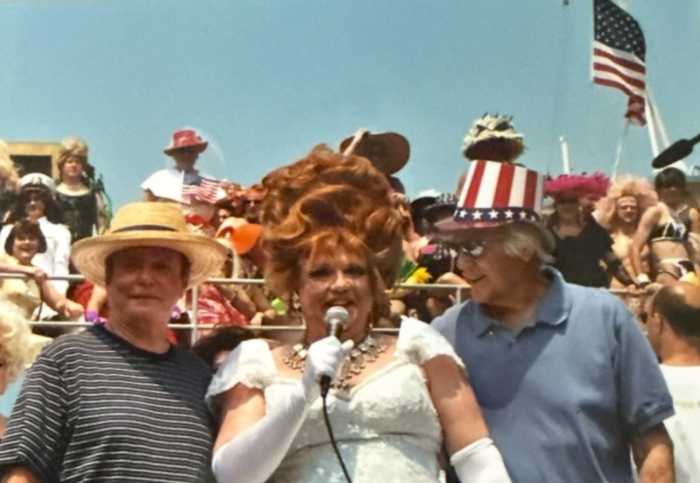On Wednesday, April 22, 2015, the Long Island Maritime Museum feted Captain Ed Mooney with its highest honor, bestowing on him the Polaris Award for Excellence stating, “The North Star – Polaris – lies very close to the celestial North Pole. [It] has been considered the most useful star in the heavens, especially to mariners. As Thomas More wrote, ‘…that star on starry nights the seaman singles out from the sky to steer his bark forever by!’”
The Museum trustees went on to say, “Each year we seek to honor individuals who share [our] vision. This year it is with great pleasure that [we have] chosen to recognize Captain Edwin J. Mooney, of Fire Island Ferries, Inc. for his outstanding contributions to Long Island’s economy and his support of [our] mission … Thank you, Captain Ed Mooney.”
That night Captain Mooney, 86 years old, was honored by the Coast Guard, a senator, a councilman, Newsday, the Lions Club, lawyers, accountants, fellow mariners in the industry, and other businesses to numerous to list here – they even included the local deli.
Edwin J. Mooney Jr. was born in Teaneck, New Jersey, in 1929 into a financially poor family, one of six children determined to make something of himself. He worked hard his whole life including odd jobs at a Hackensack boatyard where he impressed one Joseph “Socks” Lanzer.
Lanzer put him in charge of his boat also called “Socks,” a 1929, beautiful 36-foot mahogany Chris Craft powered by a 600 hp gasoline engine. (Unbeknownst to Ed, Lanzer ran the Fulton Fish Market for the Genovese crime family.) He had Ed drive the boat from Port Washington to Bay Shore where Ed subsequently ran “Socks” as a water taxi.
It was there that he met Captain Elmer (Pat) Patterson and asked him for a job. He started working as a deckhand on the “Fire Island Belle” the very next day. Ever dutiful, Ed studied hard and obtained his operator’s license (captain’s license) whereupon Patterson made him captain of the “Fire Island Maid,” the freight boat. Patterson stated that there were more senior captains but he recognized Ed’s mechanical skills at keeping boat engines running, a skill that kept him working even in the winters. The hours were long and the pay low, but Ed worked overtime for extra pay, once working 14 straight days without a break, leaving not much time for a social life for such a young man.
And then along came Patricia, the sister of another deckhand, Tom Brown. They dated. She went away to college, but they got together again when she returned after her first year. Even knowing that Ed was about to be drafted into the Army for the Korean War they married on April Fool’s Day, 1951. A month and a half later he was drafted, sent to basic training and then transferred to Fort Benning, Georgia. His son, Michael, was born shortly before he was off to Germany and France where, because of his captain’s license, he was assigned to the Army’s landing craft division out of Bordeaux, France. Ed and Pat eventually had three children: Michael, Timothy, and Kathleen (aka Casey). Family was always first with the Mooneys.
A year later, within a week of his return stateside, Patterson called on him to be captain of the “Fire Island Belle.” He was not only captain but diesel mechanic, painter and freight worker as well. Hard work never bothered Ed. He seemed to thrive on it, and he never again left the ferry company.
Meanwhile, early on in the ferry business to Fire Island, separate companies were running separate routes to the various communities on the island. The earliest ferry service to Fire Island was run by David Sammis, from Deer Park to his Surf Hotel just east of the Fire Island Lighthouse, using the dock in a town later known as Kismet.
In 1908 New York created Fire Island State Park. The first recorded ferry service started in 1922 when the Weiss family established runs from Bay Shore to the state park (also using the Kismet dock). They also ran to West Island and Camp Cheerful, a camp run for children stricken with polio.
Patterson’s father, Herbert, was the captain of the ferry to Saltaire until 1931, a service operated by the Incorporated Village of Saltaire. One of its deckhands was a guy named Frank Mina, who would later become a major player in the story of the Fire Island Ferries. Mina and Pat Patterson became close; he was like the son that Patterson never had.
Mina met Ed at the ferry terminal on Maple Avenue in Bay Shore, where Ed taught him how to handle the “Fire Island Maid,” whose berth was off in a corner of the boatyard that was difficult to access. Ed taught Mina the necessary maneuvers to safely dock the Maid. Mina later declared that that was the best job he ever had. “The freight doesn’t talk back.”
Azariah Robinson ran the first ferry to Ocean Beach starting in 1927, and ran it until 1947 when Patterson won the new contract. Patterson also resumed ferry service to Kismet at that time, but the number of passengers to and from Kismet was so sparse that if someone needed to be picked up a flag was flown at the end of the dock to alert the Ocean Beach ferry captain to stop.
During those years Robinson’s ferry franchise was called the Ocean Beach Ferry Company and Patterson’s was called the Saltaire Ferry Co. A fellow by the name of Gus Pagels started the Fair Harbor ferry under the name Cherry Grove Ferry Co. in 1931 and ran it successfully until 1972.
An actual Cherry Grove ferry system did not exist until after World War I, when a number of homes were floated across the Great South Bay to the Grove from Camp Upton, later called the Brookhaven National Laboratory. There is talk that Pagels ran ferries to Cherry Grove in competition with a family called the Steins until 1927, but there is little documentation from that long ago. It was a confusion of names in a confusing time.
The captain of the “Fire Island Queen,” and general manager/foreman of Fire Island Ferries, a man named Harold Garrett, was essential to the running of the ferry company. Patterson made everything run. Garrett made everything run smoothly. Unfortunately, Garrett had a bad heart and passed away in 1956. Ed stepped up, making more and more management decisions (and often getting yelled at by Patterson in the process). Ed was selecting boats and writing schedules, training crews, doing shipyard work, rebuilding engines, even supervising Coast Guard inspections. He was not involved in the front end, the money end, of the business. He was too busy running the operations.
In 1967 Patterson bought out his partner, Bill White, and shortly thereafter, when he was about 70 years old, he decided to sell his interest in the business.Ed was the obvious choice, so with new partners Mina and John Van Bree, a long-time bookkeeper and office manager, they purchased the ferry company with Ed as president. Van Bree continued to run the office, Mina ran the front end operations, counting the money in an all cash business, and Ed ran the boats.
Their first course of action was to build a new ferry with a new design, one capable of carrying 300 passengers at a relatively high speed. The result was the “Captain Patterson,” the first of four of a kind, a design so new that Mina had to go down to Coast Guard headquarters in Washington, D.C., to vouch for the integrity of its construction. This was quickly followed by the construction of a new freight boat, the “Vagabond.”
Van Bree only wanted to stay on for a few years and the company bought out his shares in 1975. He retired to Florida and died a few years later.
They also started an acquisition program buying up other ferry systems. In 1972 they bought the Saltaire Ferry Co. from Pagels. Two years later they bought the Fair Harbor Ferry Company fromDick Block and Bill Leyrer. The Dunewood ferry only lasted two years before going bankrupt and they took over that as well. Next was the Zeeline Ferry, purchased in 1994 for operations to Seaview and Ocean Bay Park. In 2004 they acquired the South Bay Water Taxi business pretty much locking up water access to western Fire Island.
In 1989 Ed and Mina had a serious falling out and Ed bought out Mina, deeding him a piece of property just south of the ferry terminal in settlement. They did not talk for over 30 years.
Today, Fire Island Ferries transports more than one million passengers a year, and hundreds of thousands of tons of freight. They employ almost 300 people and have trained their own fleet of homegrown captains. No small feat for a gangly kid from Teaneck.
In December 2012 Ed called Mina and they had lunch at the Oconee Diner in Islip. They talked for several hours. Ed had written a book, “Ferries to Fire Island,” in 2004 but was so unhappy with the inadequate book binding that he withheld $8K from the publisher. He also was annoyed with his family because they took away his car a few years back.
In relating the story, Mina said that Ed was “the nicest man I ever knew. We were friends for 20 years and I never once saw him lose his temper.”
Ed Mooney passed away the day after Christmas 2020, at the age of 91. Three days later the ferry company took his flag draped coffin for his last trip on the Great South Bay, a fitting farewell.Whether it was the Boy Scouts or the Cross Bay Swim, Ed was there to do what he could to help. Family was always priority number one for Ed. He loved his children and their mates, including his son, Michael, and his girlfriend, Ellen; Timothy and his wife, Jane; and his daughter, Kathleen, and her husband, Raymond. Grampy especially loved his grandkids: Brendan and his wife, Stacey; Brian (deceased in 2004); Michelle and her husband, Nick; Kelley; Brittany; Captain Morgan; James and his wife, Grace; Michael; and Christopher; and his great-grandkids: Abby, Bethany, Ryder, Freyja, and Tessa.
Ed may be gone but he will forever be the Commodore of Fire Island Ferries.T
hank you Warren James, Frank Mina, Fire Island Ferries President Timothy Mooney, and Barbara Forde of the Long Island Maritime Museum for your contributions to this article.






























